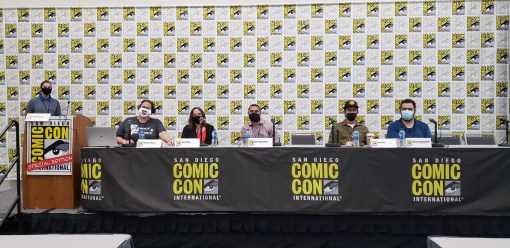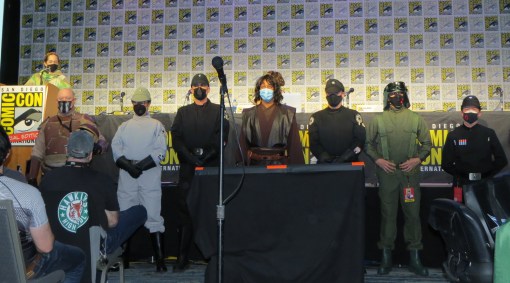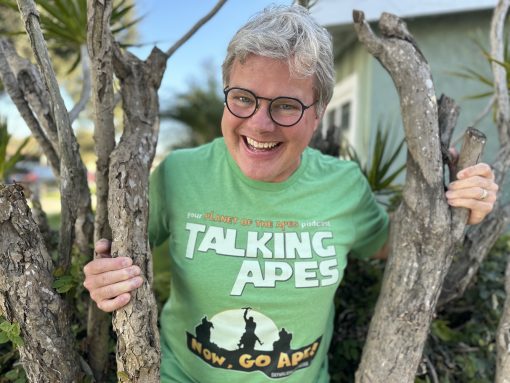How to: Present a Panel at Comic Con
Putting on a panel at Comic Con is a lot of work! I want to make it easier by sharing what I learned after successfully pitching the following three panels for Comic Con Special Edition that took place over Thanksgiving weekend.
The Science of Star Wars (referred to as SW below)
The “Science” of Fast & Furious (F&F)
The Grant Imahara Tribute Panel (tribute)
I have been going to cons for years without ever thinking about all the planning involved. The main takeaway is: prepare enough so that on the day of, any nerves can be harnessed into enthusiasm. For me, knowing I’ve thought of contingencies helps me adapt when problems arise. Also, accept any offer of help! I was doing this on a volunteer basis for the Fleet Science Center and so were my helpers who I picked up along the way.
How to Find Panelists:
The most important trait in a panelist is that they don’t have to be convinced of the premise of your panel. Growing our list of experts for Star Warsologies was a big help for the Science of Star Wars panel! We know or have reached out to academics and other experts who are also passionate about Star Wars. For the Science of Fast & Furious panel, I started with Dr. Lisa Will, who has been on Star Warsologies and I also knew to be a fan of the F&F franchise. She works at a community college and reached out to colleagues who might be interested. Tap into any and all networks you have. I posted on LinkedIn and Facebook groups I’m part of for ideas and volunteers. Don’t be afraid to reach out to people, many of them may be interested! We contacted people through Twitter, their agents using IMDb Pro, and the “Contact Us” links on websites.
For the first in-person con in years, we started with people who live in San Diego so travel wasn’t involved. The Fleet Science Center also can’t offer any sort of expenses or payment, so we had to find people willing to participate for free. With the ongoing pandemic, we also knew some people may not yet be comfortable with in-person events. If someone can’t attend, they may know another expert who would be a good fit!
How to Prep the Panelists:
I set up a Zoom meeting for each group of panelists, using a Doodle poll to pick the time. A few days in advance, I sent out questions that might get asked during the panel and solicited feedback. Panelists will know best about what they can and want to speak about. If they have time to read and respond, great, but not all will. Do not underestimate how much time and research it can take to come up with good questions! For Star Wars and Fast & Furious, I rewatched certain scenes to make sure I had the details right. For the tribute panel, I read over the article I wrote last year covering the same topic in order to find missing threads to follow.
When we met in advance, we went over the questions to make sure we were on the right track. We made adjustments. I made sure everyone knew there would be audience questions and we brainstormed some that might come up. We talked about all the day-of logistics as well. COVID rules, when and where to meet, how to pick up their badge, etc. And the basic niceties of being on a panel with others – if you interrupt someone or start to talk at the same time, make sure the conversation gets back to them. A panel is more interesting if the panelists talk amongst themselves and play off each other rather than the moderator asking a question and going down the line one by one for a response. Every panelist also doesn’t need to answer every question.
Generally, being available and the main contact for the panelists felt important. The more emails in advance, the merrier as far as I was concerned. When it came time to get everyone signed up for a badge, another round of emails went out asking for member IDs and other information.

How to Moderate a Panel:
A great moderator can really make a panel. And conversely, I’ve been to panels that could have been great if only the moderator would get out of the way. There’s a fine line to walk – you need to be enthusiastic about the subject but also realize that you’re not a panelist and the questions aren’t meant for you. I made a list of potential questions (see above for tips on that process) for each panel, with a specific expert in mind for each one rather than waiting for someone to volunteer an answer. But the moderator also has to be ready to throw the plan out the window at any point. Panels are better if they free-flow from one topic to the next. My own strategy is to have the prepared questions printed out or on index cards, but also have some blank space to write a keyword or two when you think of a new one. For me, it’s otherwise impossible to actively listen and think of new questions and transitions without either forgetting something or interrupting someone. You also have to be ready to “kill your darlings” as writers say. Prioritize questions you think are the best, but be ready to skip any or run out of time if the conversation goes another way. Make sure not to ask questions that can be answered with a simple yes or no (though this is also part of prepping your panelists, so that they give expansive answers).
Thankfully, I never had to interrupt a panelist or work hard to steer the conversation – but I was prepared to if needed. You want to make sure everyone gets a relatively equal amount of time to speak. There’s the usual personality type differences of introverted versus extroverted but more comes into play – public speaking, nerves, imposter syndrome – all of this can rear its ugly head during a panel.
How to Survive Audience Q&A:
Here’s where your best laid plans can quickly go awry. But hey, the point of a panel is to engage the audience, right? I am grateful that F&F was our first panel at Comic Con because the audience was laughing and gasping along the way in response to clips we showed from the movies and answers from the experts. So I knew they were into it and fed off that energy. The other two panels were a bit more subdued and it wasn’t until the audience Q&A (40-ish minutes in!) that I was sure people were into it. When we got great questions from people who lined up, I knew we had buy in.
Audience Q&A for science panels can be great, because there’s so many aspects that I’ve never even considered. And I love it when someone else’s brain sees something that mine didn’t. But it can also be daunting because experts are so niche. If you get a question that no one on the panel can really speak to, it can be a letdown for everyone. Next time, I’ll practice my response of “Oh interesting, we’d need a specialist but maybe it’s for this reason. Who else has a guess?” in advance, which is better than “I don’t know, cool question though.”
Thankfully, we didn’t get anything weird or gross. I’ve been in the audience for plenty of examples of this though and suggest practicing how to deflect or move on quickly. A nice (but not too nice, depending on how inappropriate it gets) way of saying, “We’re not going to answer that.”
How to Publicize the Panel:
Since tickets were still on sale for Comic Con Special Edition, I wanted to spread the word far and wide about our cool panels. There is a press list that you can send panel information and interview availability to. We didn’t take advantage of that this time, it was just one too many things for me to also put together the press release and be available as the key contact in case there were any interview requests or news stories. Next time, I’d like to make sure this happened as it really felt like going 93% of the way but just not finishing the project. However, there was still plenty I could do. I shared the news about the panels via social media and encouraged the panelists to as well. Again, I posted on group pages for people I thought were likely already attending and solicited questions to ask the panelists. I read through the entire schedule to see what other similar panels there were, and pinged some of those people to connect about our common topics.

How to do everything else!
Slides: At the very least, have one slide with the panelists social media information on it! This way it’s not an afterthought at the very end of the panel. You may not pick up a lot of followers but I certainly follow people who I find interesting on panels when I’m in the audience. We also solicited input from the panelists on what else to show. For Star Wars, if an expert knew they were going to talk about some character, ship, etc we wanted to show a screenshot so that the audience knew what we were referring to. For F&F, we realized we had to play clips instead of just show screenshots. For copyright purposes, they had to be short. And for the con, they had to be suitable for all ages. So a few days in advance, I clipped various scenes and saved them with obvious names in a folder on my desktop. I cleared the rest of my desktop so that it was only Comic Con materials. For the tribute panel, I was given access to so many amazing behind the scenes photos of Grant’s life. I spent a lot of time choosing the ones that fit in with how I thought the conversation would flow and made a powerpoint presentation.
Tech Check: The Comic Con crew allowed me to bring my gear to each room and plug in, meet the tech crew, etc. It was great to have that sorted out in advance rather than in the few minutes in between panels when everyone in the room is watching. Even with this dry run though, we had issues. I had a powerpoint for each panel plus clips for the F&F one. This required a laptop (charged or could be plugged in) and HDMI dongle (BYO). Each room had cables for screen sharing and for audio if needed. And each room had a slightly different glitch. Even though we tested earlier that day, the F&F connection glitched a few times, showing black and white “snow.” Mostly in between clips when just the background slide was up. But it was distracting and cut out completely during one of the clips for a few seconds. Totally unexplained but I went to Best Buy the next morning to buy a new dongle in case it was on my end. For SW, we just had slides and it worked fine except the laptop saw the display screen as a second monitor so the mouse got lost and we had to scroll through the slides manually versus just clicking to one when the question order changed. Again, distracting. Armed with these glitches, I arrived early for the Sunday tribute panel and thank goodness I did. It took quite a while for my laptop to play nice with their system. It would glitch out (pink and green this time) every few seconds and I really didn’t want that to happen during the panel. We tried switching dongles, HDMI cables, inputs, and anything else we could think of. Eventually the tech crew got it to work but I don’t even remember what fixed it in the end but thankfully we had a smooth presentation of the photos I’d put together. And I was able to keep the mouse on my laptop’s display screen and click around as we went.
Day-of Logistics: I brought extra KN95 masks in case any panelists couldn’t talk easily through the ones they had. I brought paper and pens in case anyone wanted to take notes. Everyone had my cell phone number in case they had any issues. I was ready to leave any panel I went to as a fan if something came up. I left my phone on and checked email regularly. Thankfully I have a new phone and the reception was great the whole time, but I was prepared with charging cables and battery packs. Everything went very smoothly, no one needed my help getting their badge picked up and everyone showed up in the right place before each panel.
Other: We had to request permission to film all of the Comic Con panels, which was just another form to fill out by a certain deadline. But it also included badges for the film crew, which meant making sure those people got information on how to get their badge, where to go, and how to set up. The tribute panel film crew didn’t show up so I had to scramble a bit. The room it was in was being filmed by both Comic Con and another outlet, so I contacted both afterwards to ask for a copy of the recording. I wish that I had also just gotten one of the volunteers to record the panel on my phone, so at least I would have something right away.
We also had to request permission to do a giveaway. For the SW panel, I commissioned some sketches from concept artist Jake Lunt Davies, who worked on all the Disney Star Wars movies. The plan was to give one to each person who asked a question. Thankfully exactly eight people asked questions in the time we had and I had eight sketches! We decided not to mention the giveaway in advance so that we’d get people who really had questions. And I also decided not to give people a choice (there were 3 sketch options: BB-8, a porg, and Rey’s speeder) because that would slow down the process of handing them out.
I also had Comic Con staffers help with including the 501st Legion in the tribute panel. They had their own panel to get to but stopped by at the very beginning to give a salute and short speech, which was a great treat. This required logistics to know what door to enter through and leave by, where to stand, when to show up, etc.

Things I learned the hard way:
Take care of yourself! I obsessed over the preparation for essentially an entire month leading up to the con. I should have taken a few more breaks, nights when I didn’t work on the project at all. But I had made a list and it always felt like there was something to do, someone to email, etc. And with only a few days to go, I burned out. My stress manifested physically and I ended up in the ER. Get enough sleep and know your limits!
Don’t prematurely end the panel! I accidentally did this with our F&F panel when I was trying to transition from audience Q&A back to one last question for the panelists. With 2 minutes left, the crowd applauded and the tech crew cut the mics and the room started to clear. There was no going back! So I missed out on the wrap up and thanking the panelists for their time and expertise. I’m still thinking about this, and it was certainly a lesson learned.
One person can’t do everything! I have long had the attitude of “if I want it done right, I’ll just do it myself.” That’s not healthy in pretty much any circumstance and I am working on it. But it certainly came up in this process. Everyone was essentially volunteering their time so emails went unanswered and my stress level rose as I had to send follow ups. I was able to chill a bit by realizing that it was going to be interesting even if we didn’t have the weeks of prep. But I wanted it to be great, which is how the to-do list you just read through came to be. I don’t want to do something halfway. But I also can’t moderate and be on every panel, I can’t answer every question, and I can’t be everywhere at once. Not to mention that I have a regular job and a life outside of this. For the month before the con, I did something to prepare nearly every single day. Whether sending emails, submitting forms, putting together slideshows, etc every lunch break or evening was spent on con prep. I took the entire day off on my husband’s birthday, but that was it. I’ll aim for a better balance next time. And certainly won’t ever try to organize three panels at one con again!
Despite all the work involved, I will definitely pitch and run panels at Comic Con (and maybe even some other cons) in the future. It was ultimately very rewarding and fun!






